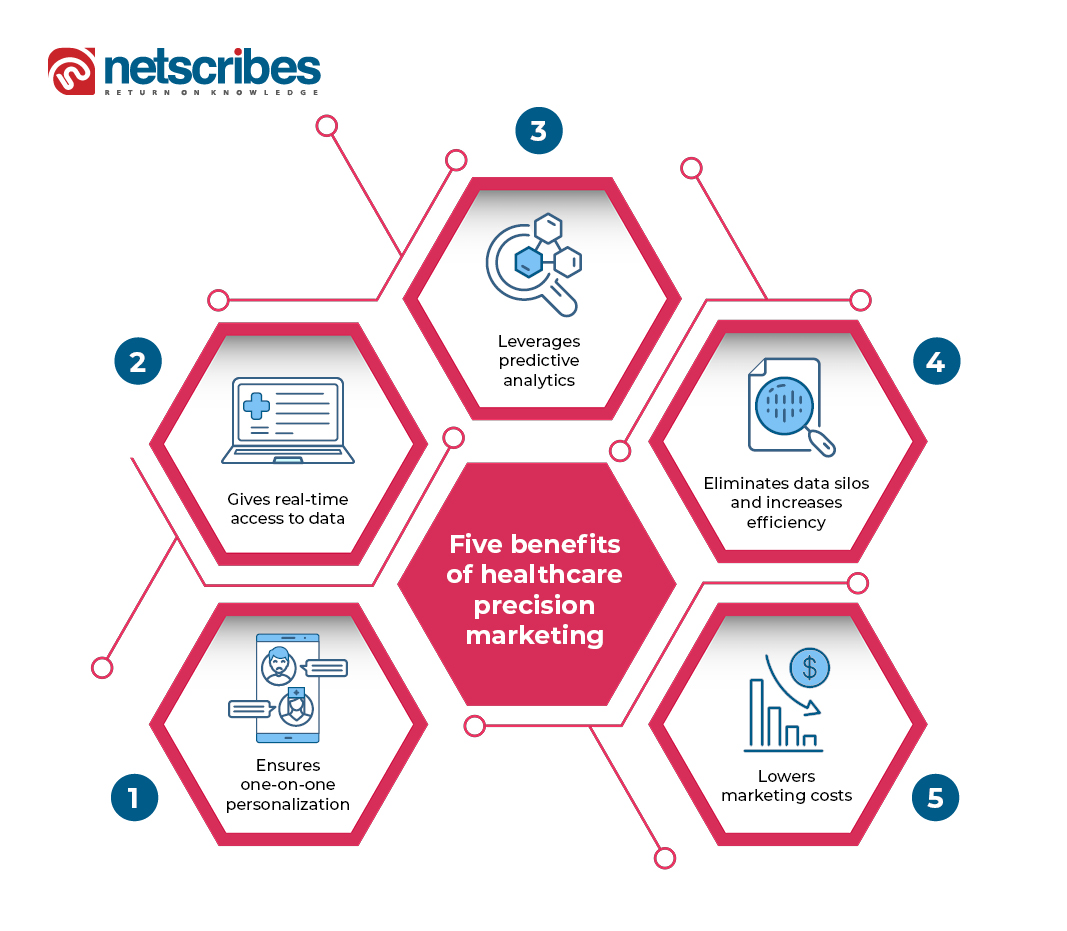Why healthcare marketers should leverage precision marketing in the new normal
Healthcare marketing has been recently experiencing an increasing rise in consumerism. These days, patients have access to a variety of information at all times, with health-related queries accounting for about 7% of all Google searches. People research their symptoms, compare expenses, read reviews, participate in internet forums, and learn about new treatments from the comfort of their own homes. As a result, patient-centric healthcare marketing has become significantly more intricate and nuanced, in the post-COVID era.
To be successful in this consumer-centric industry, healthcare organizations must address each patient’s needs individually. Predictive models can disclose vital insights and aid in the customization of patient journeys through the use of narrowly segmented audiences. This is the core idea underpinning healthcare precision marketing, a technique that many organizations are beginning to adopt.
What is healthcare precision marketing?
Healthcare precision marketing is a targeted method used to reach specific healthcare customers, including physicians, hospitals, and patients. For healthcare firms that focus on patients, this form of marketing prioritizes patient retention inside their healthcare network and long-term patient involvement across numerous healthcare journeys, ensuring patient loyalty. This retention-based approach is especially beneficial because retaining a patient is five times less expensive than acquiring a new one.
Healthcare precision marketing focuses on the following key questions
- Who are your most important consumers?
- What do you know about your target consumers?
- How do you ensure brand loyalty in your target therapeutic area (TA)?
- How can you acquire the right consumers in your TA?
Customers in any field, including healthcare, prefer to be treated as individuals rather than as part of a general service line or demographic. Precision marketing is built on this ideal. To be effective, precision campaigns make use of personal preferences and other data gathered directly from the audience. It ensures data accuracy by dividing the audience into segments based on various factors.
Healthcare providers in the new normal can collect the data required for precision campaigns from a variety of sources, including behavioral trends and location-based insights, as well as third-party analytics about their business, customers, and competitors, to supplement their in-house patient data. To derive appropriate insights, this data is then analyzed with a focus on the audience segments.
The four variables of audience segmentation in healthcare precision marketing
Healthcare precision marketing campaigns require the segmentation of your core audience, in this case – your patients. This tailored approach is especially vital when trying to stand out in today’s crowded and noisy media landscape—and may be the only way to reach increasingly difficult-to-find patients in your TAs.
Here are the four major variables that are taken into account when segmenting your target patients for precision marketing campaigns.
1. Treatment journey milestones
This segment localizes the patient based on status across symptomatic, diagnosed, treatment decision, compliant, non-compliant, and the status of patient advocates.
2. Competitive landscape
This segment recognizes the major differentiators of the healthcare firm’s product or service as they position it in the market, such as superior efficacy and/or safety, administrative ease, market access, assistance programs, and so on. Competitive knowledge about other major players in the market and data regarding their marketing campaigns also comes into play here.
3. Audience behaviors
This segment analyses the insights gathered so far to see if there are any statistically significant differences between patient segments; for example, some patients may rely on their doctors’ advice while others search online and make their own treatment decisions; these factors may be linked to demographics or geography.
4. Audience demographics
The final major variable assesses the extent to which there may be significant differences across regions, local markets, ethnic groups, and countries, especially when cultural differences lead to diverse perspectives regarding disease state relevance, motivation to treat, and adherence; location also influences reimbursement and market access.
Use cases
- Pfizer has been taking steps toward precision marketing since 2017, utilizing geographic targeting for digital ads including those promoting RxPathways – its service that connects low-income patients with free prescriptions and copay assistance. For this specific campaign, Pfizer’s team prepared a list of the 16 states with the highest numbers of uninsured patients and identified ZIP codes in those states where the most people had previously used Pfizer’s financial assistance program.
Then they used a video ad portraying a couple navigating a labyrinth sprouting up out of the street to target everyone in those ZIP codes on specific social media platforms. The off-screen voice urged patients to “get the help you need to get the prescriptions you need.” A Spanish-language version of the ad was also used to target persons in the same ZIP codes who had their social media accounts set to Spanish.
- Johnson & Johnson has leveraged consumer behavior insights to shift from mass marketing to a precision marketing approach. A consumer-centered data strategy, new analytics capabilities for audience segmentation, close-loop measurement and optimization, data governance, and best practices for precision marketing have all been established by the company.
The effectiveness of healthcare precision marketing
Healthcare precision marketing is particularly effective because it recognizes and addresses the minor differences between patients who were previously put into the same segment. It enables healthcare systems to reach specific markets and deliver messages to their patients through their chosen channels, resulting in increased satisfaction, higher retention rates, and lower costs.

Moving forward
In the post-COVID era, with continuous market fluctuations, healthcare organizations can stay ahead of the curve and put their customers first, through their precision marketing activities. Marketers can embrace granular growth opportunities and enter the recovery with considerably more ROI and resilience by acquiring new patient data, searching for new behavioral relationships, and enabling rapid experimentation.
Netscribes offers full-service healthcare market research to global organizations in a variety of healthcare domains. To know more about how we can assist your company in keeping up with the current market and consumer trends, contact us today.


